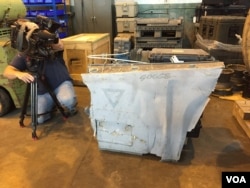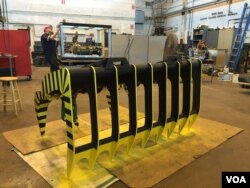It's dusty, cavernous, and noisy, but this warehouse, located on the waters of the Chesapeake Bay in Annapolis, Maryland, has the tools for going to the deepest ocean depths to solve mysteries -- such as the disappearance of aircraft and ships.
Eclipse Group Inc. specializes in underwater debris. They found an F-14 Tomcat fighter jet in the Mediterranean, and explored artifacts from the Titanic.
Their Remotely Operated Vehicle (ROV), sent back photos of the Titanic's grand staircase and first-class cabins.
If retracing the journey of the flaperon and other debris from Malaysia Airlines Flight 370 leads to a crash site, a company such as Eclipse Group could handle the recovery.
Finding MH370
It's tough for experts to "reverse search" a plane crash, says Steven Saint Amour, the founder of Eclipse Group.
"The fact that something was found was a stroke of luck. But I think it will probably be just as difficult as before. Finding the debris is just confirming the aircraft is in the water. Not that anyone had any doubts about that," Saint Amour says.
The plane debris was carried by the West Australian current, flowing counterclockwise, he says.
Saint Amour believes the debris swept up the Australian coast and made a sharp turn west before swinging across the Indian Ocean, breaking up at Madagascar and its surrounding islands, one of which is Reunion, where the MH370 flaperon was found.
He said he expects more debris to be found: "The more debris they can find and its location can better determine where this debris originated from."
If experts find a new search location, a side-scan sonar would look for a debris field. Then a recovery company, such as Saint Amour's, would use an ROV to investigate.
The ROV, controlled from a ship on the surface, has cameras and steel hands that can pick up pieces.
Eclipse is building a new ROV capable of reaching depths of 6,000 meters (19,700 feet), which would be necessary in the Indian Ocean in the areas of the missing plane search.
An enormous yellow and black claw is at the front of the ROV.
"You have sometimes where fishermen trawl and catch their nets on shipwrecks. The claw is to go down and remove the obstruction so the ROV can work carefully," said Brian Parsons, Eclipse's chief science officer.
Closure
Parsons says his work is satisfying because of the people who are connected to the disasters.
"If in case we do recover some pieces from the sea floor, then it will end up shedding light on maybe what happened, in addition to giving families ultimate closure that the plane is not on some island somewhere," he says.
The next search for MH370 depends on money and time, Saint Amour says.
"The search that’s been undertaken is unprecedented. The resources thrown at this are pretty amazing," he says. "A lot of credit goes to the Australians for undertaking all this. It will come down to money at this point. The Indian ocean is huge. It could be years before they find this thing – if ever."












